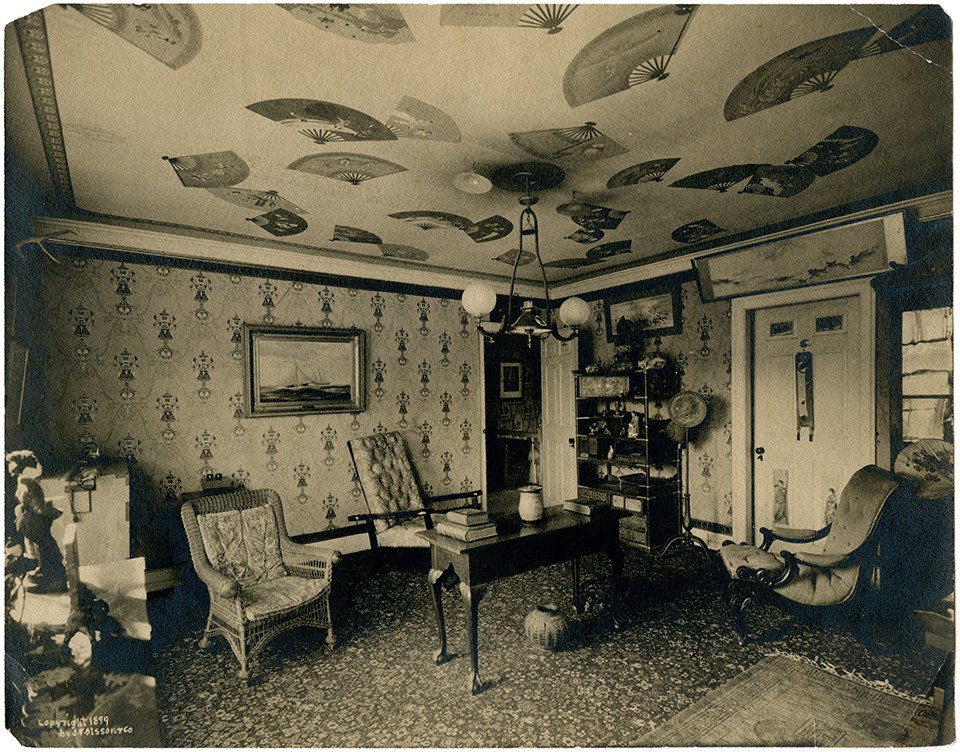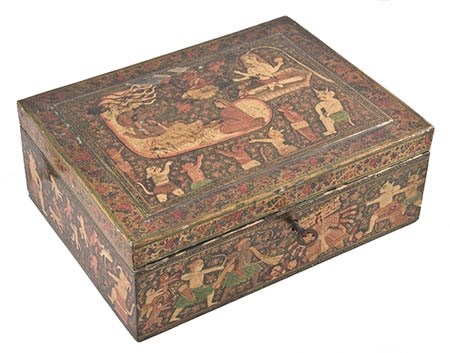
Buildings and Grounds Photograph Collection (3008-2-9-4) This room is part of the ell added in the 1790s addition by Andrew Craigie. It served several functions over the house's history - housing for the Craigie servants, a room for Samuel Longfellow during his Harvard Divinity School studies, a temporary nursery, and a schoolroom under governess Hannah Davie. From 1917 until his death in 1950, it served as Harry Dana's office, with his desk, floor to ceiling bookcases, typewriters, and a telephone. However, the room is most notable for its use by Charles Longfellow to display his treasures collected on his travels. He furnished the room with Civil War memorabilia, items from his travels in India, and eventually furniture and art collected during his time living in Japan. 
Buildings and Grounds Photograph Collection (3008-2-9-2) MemorabiliaUpon Charles Longfellow's return from the Civil War, his two cavalry sabers found a home displayed crossed over the mantel with a bugle. Close examination of the 1870 photograph of the room reveals boxing gloves, pipes, a coal fireplace, a pull cord for the servants, and a gas light. A cream and red paper was on the walls. 
NPS Photo / Museum Collection (LONG 17810) Charles the East-India ManCharley wrote to his father from India asking about putting in a door between the two northernmost rooms in the ell on the second floor. Charley planned to make a suite for himself, decorated with the Indian objects he was acquiring during his travels. Upon his return to Cambridge in the fall of 1870, Charley established his new lodgings in the rear of the house and decorated it with objects from India. His sister Edith wrote: "His room is beginning to look quite gorgeous with all his new things…" Although Charley was often away travelling, his family and friends used his sitting room, taking delight in its exotic "curiosities." In 1874, Charley removed most of his Indian items from this room, and few of these pieces survive in the collection today. 
NPS Photo / Museum Collection (LONG 23311) Almost Entirely Japanese ThroughoutCharles Longfellow was among the earliest American visitors to Japan, staying in the country for an extended period in 1871-1873. While there, he acquired a large number of pieces of Asian art and sent them home to Cambridge. His father admonished him, "Don't ruin yourself in buying strange bronzes. You will have a perfect museum of curiosities; and I shall have to put a Mansard roof on to your part of the house to hold them!" However, when unpacking the boxes, he expressed delight with the screens his son had acquired. Charley redecorated his sitting room in 1874 when he returned from his travels in Japan and China, using many of the pieces he had shipped home. He wallpapered the room with an Asian pattern and placed Japanese fan-shaped paintings on the ceiling. Close examination of a photograph documenting the room in 1899 reveals many items still in the collection today, including lacquer shelves, an elaborate bodhisattva sculpture, a painting of Mount Fuji, a Japanese trunk, and a counterfeit antique Chinese bronze vase. |
Last updated: March 30, 2023
